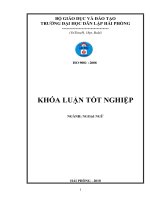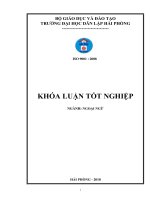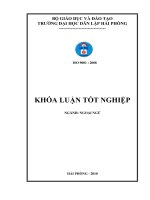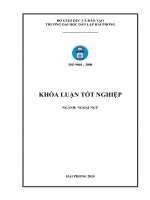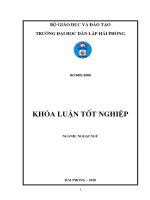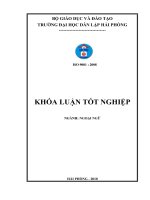A STUDY ON ENGLISH EXPRESSIONS USED IN WEBSITE DESIGN AND VIETNAMESE EQUIVALENCE
Bạn đang xem bản rút gọn của tài liệu. Xem và tải ngay bản đầy đủ của tài liệu tại đây (369.44 KB, 59 trang )
BỘ GIÁO DỤC VÀ ĐÀO TẠO
TRƯỜNG ĐẠI HỌC DÂN LẬP HẢI PHỊNG
------------------------------
ISO 9001 : 2008
KHĨA LUẬN TỐT NGHIỆP
NGÀNH: NGOẠI NGỮ
HAI PHONG 2010
HAI PHONG PRIVATE UNIVERSITY
DEPARTMENT OF FOREIGN LANGUAGE
--------------------
ISO 9001 : 2008
GRADUATION PAPER
A STUDY ON ENGLISH EXPRESSIONS USED IN WEBSITE
DESIGN AND EQUIVALENCE IN VIETNAMESE
By: Nguyễn Văn Cương
Class: Na 1002
Supervisor: Nguyen Thi Phi Nga, MA
HAI PHONG 2010
CỘNG HÒA XÃ HỘI CHỦ NGHĨA VIỆT NAM
Độc lập – Tự do – Hạnh phúc
----------------------------
BỘ GIÁO DỤC VÀ ĐÀO TẠO
TRƯỜNG ĐẠI HỌC DÂN LẬP HẢI PHÒNG
NHIỆM VỤ ĐỀ TÀI TỐT NGHIỆP
Sinh viên:.................................................................Mã số: ...............................
Lớp: ....................................................... Ngành: ...............................................
Tên đề tài: ..........................................................................................................
............................................................................................................................
............................................................................................................................
Nhiệm vụ đề tài
1. Nội dung và các yêu cầu cần giải quyết trong nhiệm vụ đề tài tốt
nghiệp
( về lý luận, thực tiễn, các số liệu cần tính tốn và các bản vẽ).
……………………………………………………………………………..
……………………………………………………………………………..
……………………………………………………………………………..
……………………………………………………………………………..
……………………………………………………………………………..
……………………………………………………………………………..
……………………………………………………………………………..
……………………………………………………………………………..
2. Các số liệu cần thiết để thiết kế, tính tốn.
……………………………………………………………………………..
……………………………………………………………………………..
……………………………………………………………………………..
……………………………………………………………………………..
……………………………………………………………………………..
……………………………………………………………………………..
……………………………………………………………………………..
……………………………………………………………………………..
……………………………………………………………………………..
3. Địa điểm thực tập tốt nghiệp.
……………………………………………………………………………..
……………………………………………………………………………..
……………………………………………………………………………..
PHẦN NHẬN XÉT CỦA CÁN BỘ HƯỚNG DẪN
1. Thái độ của sinh viên trong quá trình làm đề tài tốt nghiệp:
............................................................................................................................
............................................................................................................................
............................................................................................................................
............................................................................................................................
............................................................................................................................
2. Đánh giá chất lượng của Đ.T.T.N (so với nội dung đã đề ra trong nhiệm
vụ Đ.T.T.N trên các mặt lý luận, thực tiễn, tính tốn giá trị sử dụng và chất
lượng các bản vẽ)
............................................................................................................................
............................................................................................................................
............................................................................................................................
............................................................................................................................
3. Cho điểm của cán bộ hướng dẫn:
( Điểm ghi bằng chữ):
Hải Phòng, ngày….. tháng…. năm 2010
Cán bộ hướng dẫn chính
( Họ tên và chữ ký)
NHẬN XÉT ĐÁNH GIÁ CỦA CÁN BỘ CHẤM PHẢN
BIỆN ĐỀ TÀI TỐT NGHIỆP
1. Đánh giá chất lượng đề tài tốt nghiệp về thu thập và phân tích số liệu ban
đầu, cơ sở lý luận chọn phương án tối ưu, cách tính tốn chất lượng thuyết
minh và bản vẽ, giá trị lý luận và thực tiễn đề tài.
2. Cho điểm của cán bộ phản biện ( Điểm ghi bằng số và chữ)
Hải Phòng, ngày…. tháng…. năm 2010
Người chấm phản biện
CÁN BỘ HƯỚNG DẪN ĐỀ TÀI TỐT
NGHIỆP
Người hướng dẫn
Họ và tên
:
Học hàm học vị
:
Cơ quan công tác
:
Nội dung hướng dẫn
:
Đề tài tốt nghiệp được giao ngày…….tháng…….năm 2010
Yêu cầu phải hoàn thành trước ngày…….tháng……năm 2010
Đã nhận nhiệm vụ Đ.T.T.N
Đã nhận nhiệm vụ Đ.T.T.N
Sinh viên
Cán bộ hướng dẫn Đ.T.T.N
Hải Phòng, ngày…..tháng……năm 2010
HIỆU TRƯỞNG
ACKNOWLEDGEMENTS
From the bottom of my heart, I would like to show my deepest
gratitude to many people helping and encouraging me enthusiastically in
preparing and completing the graduation paper.
First of all, I would like to express my heart felt thanks to Mrs. Nguyen
Thi Phi Nga (MA) - my supervisor and Mr Vo Van Thuong – my teacher who
has given me many valuable guidance, precious advice and cautious
correction which help me much in completing this paper.
Also, I would like to thank Ms. Tran Thi Ngoc Lien – Dean of Foreign
Language Department for her help during my completion of the paper.
Next, I am also grateful to all teachers at Hai Phong Private University
whose support and advices has improved my study.
Last but not least, I own sincere thanks to all members of my family
and friends for whatever they supported and encouraged me both mentally
and physically in the progress of writing this graduation paper.
I know my graduation paper still keeping mistakes for my
shortcomings. I would like to receive your comments, suggestions and
corrections for the perfect of my own graduation paper.
Hai Phong, July 2010
Nguyen Van Cuong
TABLE OF CONTENTS
ACKNOWLEDGEMENTS
PART I: INTRODUCTION .................................................................................... 12
1. Rationale of the study ........................................................................................... 12
2. Aims of the study ......................................................................................................2
3. Scope of the study ....................................................................................................2
4. Methods of the study............................................................................................. 13
5. Design of the study ...................................................................................................3
PART II: DEVELOPMENT.......................................................................................4
CHAPTER I: THEORETICAL BACKGROUND ...............................................4
I_ Translation theory ....................................................................................................4
1.1 Concepts of Translation and Equivalence in translation ..............................4
1.1.1 Concepts of translation ......................................................................................4
1.1.2 Concepts of equivalence in translation ..........................................................5
1.2 Translation methods...............................................................................................6
1.2.1 Word-to-word translation: ................................................................................6
1.2.2 Literal translation: ...............................................................................................6
1.2.3 Faithful translation: ............................................................................................7
1.2.4 Semantic translation: ..........................................................................................7
1.2.5 Adaptation: ...........................................................................................................7
1.2.6 Free tranlation:.....................................................................................................7
1.2.7 Idiomatic translation: .........................................................................................8
1.2.8 Communicative translation: .............................................................................8
II_ Equivalence in translation ....................................................................................8
III_ESP in translation ................................................................................................ 20
3.1 Concept of ESP:................................................................................................... 20
3.2 Types of ESP: ....................................................................................................... 21
IV_ Term in Website Design field ......................................................................... 22
4.1 What is term?........................................................................................................ 22
4.2 The characteristics of terms .............................................................................. 23
CHAPTER II: AN ENGLISH TRANSLATION OF WDT RELATING TO
LANGUAGE OF STATIC AND DYNAMIC WEBSITE INTO
VIETNAMESE. .......................................................................................................... 23
I_ Typical Terms relating to Static Website ........................................................ 23
1.1 Definition and structure of HTML .................................................................. 23
1.1.1 Definition of HTML........................................................................................ 24
1.1.2 Structure of an HTML .................................................................................... 24
1.2 Typical Terms relating to HTML .................................................................... 24
II_ Typical Terms relating to Dynamic Website ................................................ 32
2.1 Definition and structure of PHP ...................................................................... 32
2.1.1 Definition of PHP ............................................................................................ 32
2.1.2 Structure of a PHP ........................................................................................... 33
2.2 Typical Terms relating to PHP ........................................................................ 33
III_ Translation of common WDT abbreviations ............................................... 36
IV_ Procedures that are employed to translate English WDT abbreviations
into Vietnamese .......................................................................................................... 44
4.1 Literal translation ................................................................................................ 45
4.2 Calque translation ................................................................................................ 47
4.3 Translation by using loan word ....................................................................... 48
4.4 Translation by paraphrasing ............................................................................. 49
4.4.1 Translation by paraphrasing using related word ...................................... 49
4.4.2 Translation by paraphrasing using unrelated word ................................. 50
4.5 Addition and omission ....................................................................................... 51
CHAPTER III: MAIN FINDINGS ........................................................................ 51
I. Common Mistakes in understanding ................................................................. 52
II. Some suggestions .................................................................................................. 52
2.1 At Word level ....................................................................................................... 52
2.1.1 Recognized translation ................................................................................... 53
2.1.2 Translation by calque ...................................................................................... 53
2.1.3 Translation by paraphrasing .......................................................................... 53
2.2 At above word level ............................................................................................ 54
2.2.1 Literal translation ............................................................................................. 54
2.2.2 Translation by paraphrasing .......................................................................... 54
2.2.3 Translation by omission or addition ............................................................ 54
2.3 New terminologies .............................................................................................. 55
PART III: CONCLUSION ...................................................................................... 55
1. Summary of the study ........................................................................................... 55
2. Suggesions for further study ............................................................................... 57
REFERENCES ........................................................................................................... 57
PART I: INTRODUCTION
1. Rationale of the study
Nowadays, Internet has become the most ever powerful tool for man
throughout the world. The Internet is a collection of various services and
resources such as: communication, information, entertainment, business,
education therefore knowledge of IT, Internet terms, website design terms
(WDT) is very important and necessary for everyone.
We are living in a technology – driven century where it is essential that
people are familiar with relevant information technology terms. However, the
learners as well as the readers sometimes feel much confused about
translation Internet terms, IT terms and WDT thoroughly. Students in the
process of acquiring this language are always aware that it greatly contributes
to bring different nations with different languages and culture close together.
And, I myself realize that Internet is not only of vital spiritual value of people
but also serves as one of the best ways for better understanding between
nations, especially in the globalization process. During my internship at
Quang Binh Import & Export JSC, I have experienced opportunities
contacting with a lot of Website Design Terms (WDT) I realize that it is
necessary to study on WDT. I, an English-major, find it not easy for
everybody but very interesting to study further this global language. The
difficulties come from different factors including cultural, terminology usage
and language in use; however, one of the parts that attract much of my
attention is the working on the function language in use and expression in
these terms which during the preliminary research, I myself found prominent.
This causes readers certain difficulties in understanding and perceiving WDT.
Therefore, it drives me to conduct a more thorough study on the
problem. I hope that from the comparative study between English and
Vietnamese terms in website, we can find similarities and also differences.
Website makes it simple and easy to gather information when you are
searching through the Internet. You will find endless amounts of information,
about everything, and all at your fingertips. The Internet is the largest source
of knowledge in the world.
With the hope that this study can be useful material, interest readers
somehow and they would find it helpful, I have chosen the topic “A Study on
English Expressions used in Website Design and Vietnamese equivalence.” as
my research paper.
Following this trend, the study will serve purposes:
2. Aims of the study
For the above- mentioned reasons this paper mainly focuses on:
Pointing out the definition of web language, the process of designing
web pages, classifying of static and dynamic website languages
Collecting and presenting some commonly used WDT in English
Providing some ways of Vietnamese equivalents or expressions
Helping all people who encounter some troubles in acquainting with
WDT especially when you design website you can understand it properly.
3. Scope of the study
Because of the knowledge, experiences, and time frame. I could not
take a study on all related to the WDT but only deal with the popular terms in
WDT presented in some textbooks and materials that are used for teaching,
learning specialized English in faculty of IT and designing website.
Therefore, my research paper is also limited to the presentation and
discussion of English terms and Vietnamese equivalences. Hopefully, my
research will partly help student have a general overview on WDT and their
effective use in such kind of works.
4. Methods of the study
To study successfully and effectively in my studying process, with the
hope of creating my research pleasant to read, I have implemented the
following methods:
Firstly, grammar books are collected up from many resources to
develop the topic.
Secondly, the study is completed due to information collected from
Internet or websites and books concerning to compliments and responses to
get theoretical background.
Next, the analysis on books, newspapers and dictionaries is carried to
get bases knowledge and specific exemplifications for compliments and
responses.
Last, personal observation, experience and interviews are also utilized
to fulfill my study.
5. Design of the study
The graduation paper composes three parts in which the second part is
the most important one.
Part I: Introduction that includes Rationale, Aims of the study, Scope,
Methods and Design of the study.
Part II: Development that states three chapters.
Chapter 1: Theoretical background
Chapter 2: An investigation on English expressions used in website design
and Vietnamese equivalence.
Chapter 3: Main findings
Part III: Conclusion that gives a brief summary of the study and suggestions
for further research.
PART II: DEVELOPMENT
CHAPTER I: THEORETICAL BACKGROUND
I_ Translation theory
1.1 Concepts of Translation and Equivalence in translation
1.1.1 Concepts of translation
Translation has existed in every corner of our life. It is considered as an
indispensable part in the field of not only literature, culture and religion but
also commercial advertisement, popular entertainment, public administration,
international diplomacy, scientific research publication, judiciary procedure,
immigration and education ….Thus, there are many concepts of translation all
over the world. Following is some typical concepts:
Translation is the process of changing something that is written or
spoken into another language.
_Advanced Oxford Dictionary_
Translation is the replacement of a text in one language (Source
language-SL) by an equivalence text in another language (Target languageTL)
_Encyclopedia of language and linguistics_
Translation consists of producing in the target language the closest
natural equivalent of the source language message, firstly with respect to
meaning and secondly with respect to style.
_Eugene A. Nida (1959)_
Translation is the interpreting of the meaning of a text and the
subsequent production of an equivalent text, likewise called a "translation"
that communicates the same message in another language. The text to be
translated is called the "source text," and the language that it is to be
translated into is called the "target language"; the final product is sometimes
called the "target text."
_Wikipedia_
Translation is to be understood as the process whereby a message
expressed in a specific source language is linguistically transformed in order
to be understood by readers of the target language"
_ Houbert (1998:1)_
1.1.2 Concepts of equivalence in translation
Equivalence-oriented translation is a procedure which replicates the
same situation as in the original, whilst using completely different wording.
_Vinay and Darbelnet_
Equivalence, when applied to the issue of translation, is an abstract
concept and actually refers to the equivalence relationship between the source
text and the target text.
_Asian social science (CCSE)_
Translation equivalence exists between forms in a source language and
a target language if their meaning matches. In other words, translation
equivalence should answer the question “What do the speakers of this
language actually say to express the desired meaning?”
_Wayne Leman (Wordpress.com)_
Although these definitions are different in expression, they share
common features about finding the closest equivalent in meaning by the
choice of appreciate target language‟s lexical and grammatical structures,
communication situation, and cultural context .Some sort of movement from
one language to another also depends on translation methods that will be
show in the next part.
1.2 Translation methods
There are various ways or methods by which a text may be translated.
The central problem of translating is whether to translate literally or freely. It
all depends on some factors such as the purpose of the translation, the nature
of readership and the text types.
As stated by Peter Newmark (1988) there are eight methods of
translation, namely: Word-to-word translation, Literal translation, Faithful
translation, Semantic translation, Adaptation, Free translation, Idiomatic
translation, Communicative translation
1.2.1 Word-to-word translation:
This is often demonstrated as interlinear translation, with the TL
immediately below the SL words. The SL word-order is preserved and the
words translated singly by their most common meaning, out of context.
E.g: Thomat is the student living and studying in German.
Thomat là một sinh viên đang sống và học tập ở Đức
1.2.2 Literal translation:
The SL grammatical consruction is converted to the nearest TL
equivalents but the lexical words are again translated singly, out of context.
E.g:
John put all his whole year - savings in studying computer
programming.
John đã đặt tất cả số tiền dành dụm được cả năm để học lập trình máy tính.
1.2.3 Faithful translation:
Faithful translation attempts to reproduce the precise contextual
meaning of the original within the constraints of the TL grammatical
structures.
E.g:
So many men, so many minds.
Lắm thầy nhiều ma.
1.2.4 Semantic translation:
Semantic translation differs from faithful translation only in as far as it
must take more account of the aesthetic value of the SL text, compromising
on “meaning” where appropriate so that no assonance, word-play or repetition
jars in finished version.
E.g:
So many men, so many minds.
Làm dâu trăm họ.
1.2.5 Adaptation:
This is the freest form of translation mainly used for plays and poets:
themes, characters, plots preserved, SL culture converted to TL culture and
text is rewritten. Dung Vu (2004) points out: “Adaptation has a property of
lending the ideas of the original to create a new text used to by a new
language more than to be faithful to the original. The creation in adaptation is
completely objective in content as well as form
1.2.6 Free tranlation:
Free translation reproduces the matter without the manner, or the
content with out of the form of the original.
In free translation, there is a special form called “Adaption”. This is the
“freest” form of translation.
E.g: To reduce fertility rate the present 3.7 children per woman to
replacement level of 2.
Tỉ lệ sinh hiện tại của phụ nữ giảm từ 3,7 xuống còn 2 trẻ.
1.2.7 Idiomatic translation:
Diomatic translation reproduces the “message” of the original but tends
to distort nuances of meaning by preferring colloquialisms and the idiom
where these do not exists in the original.
E.g:
Clothes make man.
Người đẹp vì lụa, lúa tốt vì phân.
1.2.8 Communicative translation:
Communicative translation attempts to reader the exact contextual
meaning of the original in such a way that both content and language are
readily acceptable and comprehensible the readership.
E.g:
Hello! How are you?
Lâu lắm không gặp! Cậu dạo này thế nào?
II_ Equivalence in translation
The translation of text between different languages inevitable involves
a theory of equivalence. According to Vanessa Leonardo “Equivalence can be
said to be the central issue in the translation although its definition, relevance,
and applicability within the fields of translation theory have caused heated
controversy, and many different theories of the concept of equivalence have
been elaborate approaches to translation equivalence:
Nida (1964) distinguishes formal equivalence and dynamic translation
as basic orientations rather than as abinary choice:
Formal equivalence is achieved when the SL and TL words have the closet
possible match of form and content.
Dynamic equivalence achieved when the SL and TL words have the same
effect on their effective readers.
Newmark (1988) defines: “The overriding purpose of any translation should
be achieved equivalence effect i.e. to produce the same effect on the
readership of translation as was obtained on the readership of the original” He
also sees equivalence effect as the desirable result rather than the aim of any
translation except for two cases:
+ If the purpose of the SL text is to effect and the TL translation is to inform
or vice versa.
+ If there is a pronounced cultural gap between the SL and the TL text.
Koller (1979) considers five types of equivalence:
Denotative equivalence: The SL and the TL words refer to the same thing in
the real world. It is an equivalence of the extra linguistic content of a text.
Connotative equivalence: This type of equivalence provides additional values
besides denotative value and is achieved by the translation‟s choice of
synonymous words or expressions.
Text-normation equivalence: The SL and the TL words are used in the same
or similar context in the respective languages.
Pragmatic equivalence: With readership orientation, the SL and TL words
have same effect on their respective readers.
Formal equivalence: This type of equivalence produces an analogy of form in
the translation by either exploiting farmal possibilities of TL or creating new
forms in TL.
III_ESP in translation
3.1 Concept of ESP:
- ESP is the abbreviation for English for Specific Purpose. It is defined
in the other ways. Some people described ESP as simply being the teaching of
English for any purpose that could be specified. Others, however, were more
precise, describing it as the teaching of English used in academic studies or
the teaching of English for vocational or professional purposes.
As for broader definition of ESP, Hutchinson and Warters (1987)
theorize, “ESP is an approach to language teaching in which all decisions as
to content and method are based on the learners‟ reason for learners.” (p.19).
Anthony (1997) notes that it is not clear where ESP courses end and general
English courses begin; numerous non-specialist ESP instructors use an ESP
approach in that their syllable are based on analysis of learners needs and
their own personal specialist knowledge of using English for real
communication.
-Theorists Dudley-Evans and St John (1980 modified Stevens‟s original
definition of ESP Journal gives an extended definition of ESP in terms of

